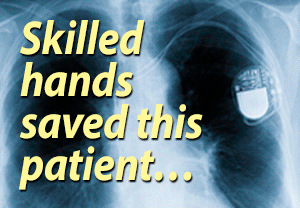 Cardiac rehabilitation & exercise stress testing to optimize rate adaptation
Cardiac rehabilitation & exercise stress testing to optimize rate adaptation
- by darmaggi
- 2018-12-17 17:45:55
- Exercise & Sports
- 1308 views
- 7 comments
I had a state of the art Biotronik Eluna 8 DR-T (dual chamber) implanted last year after my 2nd degree AV block type II (Mobitz) got progressively worse over a period of years of living with it. It usually manifested as exercise induced spontaneous bradycardia with accompanying arrhythmia that would be triggered when I reached a specific HR threshold.
I had the PM programming set initially the day after surgery, and re-programmed twice since then all in an effort to optimize the pacing, and more specifically to get the rate adaptation more sensitive to my highly active lifestyle. It is now on the CLS (closed loop stimulation) setting as it's promoted as the best for rate adaptation, but I've still got issues with it's sensitivity to my exercise regimen. Specifically, it seems more often than not that the PM can't figure out when I'm cycling, which I do almost daily. I've been told it could be the resting rate control, which had a cap in the 90bpm range with a +10 that was just changed to a +20, that could be keeping it from pacing up into the 130-150 range, and partly because when I'm cycling my body position doesn't change and the accelerometer isn't getting engaged. I've tried "tapping up" by manually manipulating my chest while riding to stimulate the accelerometer to no avail, and even if I do a series of jumping jacks or whatever to elevate my HR before I jump on my bike, it's only a matter of time before it will drop back down and then seemingly get "stuck" at the lower rate.
I'm curious if anyone else out there with a similar issue, and possibly similar PM has found specific programming that worked well, either with the CLS and then tweaking the parameters inside CLS, or any other programming modes that were better at rate adaptation.
I'm also curious if anyone was scheduled by their doctor for cardiac rehabilitation, so you could have an exercise strees test with techinician present to tweak the settings real time while imitating your normal exercise patterns.
I've gotten copies of follow up reports so if need be I can refer to them for more specific information about the different parameters set inside the CLS programming mode, but generally right now my parameter overview is DDD-CLS mode, with a basic/night rate of 40bpm and CLS of 150.
Any information or suggestions are much appreciated.
Thanks,
darmaggi
7 Comments
without CLS
by Tracey_E - 2018-12-17 21:54:58
Might be a stupid question, but have your turned off CLS? If you only have av block, then the CLS may be causing more problems than it solves because av block usually means the sinus node works normally and the pacer's only job is to make sure the ventricles beat when the atria does. I have both av block and chronontropic incompetence, getting my settings right was a long process that involved getting on a treadmill while on the pacer computer and eventually being a SJM case study. But that wasn't CLS.
She hasn't been around in a while but if you do a search for CLS then look for posts by golden_snitch, she gives a great explanation of how it works and what she went through getting hers programmed.
Dave, CLS works totally differently than the rate response in a Medtronic which goes by your movement alone. CLS learns your habits.
my 2 cents
by Skeet - 2018-12-17 23:35:46
Tracey-E seems to know what she is talking about, I hope she helps. It is people like her that have already experienced the problem that seems to help the most. Most Drs. and techs don't have pacemakers and have no real first hand experience, Here is the main problem. We are in the 1%. I am a cyclist also. It was five years before I saw the same tech twice. Techs are trained to treat the 99%, and those are the people that just want to wake up in the morning not ride there bike, play golf, go to the gym, or do any of the other activities we love.
In my first ten or so pacemaker clinics (five years) there was not one PM dependent person there that could even walk 100 feet, and I wanted to ride my bike 100 miles. The difference there is astronomical and the ability to program the PM, it seems, is also. There must not be many techs around that can do it, and harder than that, is finding one that can.
Darmaggi, I loved that line "more often than not that the PM can't figure out when I'm cycling". That is what it seems like. It seems it shouldn't be that hard. When going easy not a lot of pulse, when going hard more pulse. Hope you get your situation resolved soon. I am seeing my tech tomorrow, so after 2 PMs and 11 years we are still working on mine.
Skeet
Fine tune
by JoanneMT - 2018-12-18 10:52:19
I got a Biotronik Edora implanted end of October. Since then they have reprogrammed my Pm 3 times (once by a technician of Biotronik). I am not an expert thus. What I learned from this:
-the lead sensitivity can be adapted. My heart was racing from 80 to 120 for just going to the next room. The sensitivity was adapted to lower and it was a lot better. Maybe they should up the sensitivity in your case.
- After each change in the programming, your body and the pacemaker have to learn from each other as the knowledge build up before is lost. So the first 2 weeks you should feel worse and than it should improve. They do a print out of the "performance", this should be a smooth graph..... If not yet you and your PM could still be in a learning curve.
Ask whether the adaptation of the lead sensitivity could be interesting for you?
Who does the programming your cardiologist or a Biotronik technician? The last one knows your Pm in and out. Be naughty and contact Biotronik if no response from your doctor.
Exercise and optimizing my Biotronik Eluna 8 DR-T on CLS programming
by darmaggi - 2018-12-19 19:37:33
JoanneMT,
Biotronik techs have always run the reports and set or changed any programming. I've called Biotronik's U.S. office several times and had lenghty conversations with techs there, and it's usually them that give me suggestions on avenues to pursue with the local tech. I was under the assumption that my PM is supposed to "learn" who I am and my specific / routine demands, but so far it seems my PM didn't graduate Summa Cum Laude from the factory.
Tracey_E,
Thanks for the tip off on golden_snitch, I've found her and the site archives all posts and she's posted several times regarding CLS, so I haven't had a chance to read them yet, but I will.
I wasn't originally on the CLS programming, and the day after I had it implanted the Biotronik tech who set the programming mentioned that my blockage was an AV and that my atrium were for all intents and purposes "normal". So I will have to do more research regarding CLS and possible confusion when the sinus node and atrium are normal. I actually have the second degree AV block and have had a RBBB block much longer. Decades ago I was told I had a MVP (mitral valve prolapse), and I'm not sure if that was an artifact from having Rheumatic Fever once as a child and once as an adult, or was misdiagnosed. Possibly once the RBBB cropped up a MVP was nothing to worry about and was supplanted by the RBBB so then faded in the rearview mirror.
I'm surprised, especially for someone as athletic as I am, that getting on a treadmill with a tech present for some "Cardiac Rehabilitation" isn't automatically done. Now that I've complained several times of the PM not allowing me to exercise at a level I was used to and that I'm perfectly fit for otherwise, or that it seems to get stuck at a lower level, I'm wondering why they haven't suggested some Cardiac Rehab with a stress test.
Skeet,
I don't doubt that techs and or cardiologists in general don't see a lot of highy trained athletes that they are putting pacemakers in, so not only do they not have a base of patients like us with similar issues, our athletic issues in combination with our specific electrical blockages combined with the pacemakers ability and programming limitations creates a tiny subset for them to figure out and dial in just right.
Worst comes to worst I can ride my bike on the flats forever with my HR in the 50-60's and get used to getting passed by the oldest, fattest most out of shape cyclists in the world, like I used to before the PM implantation, but I'd rather get my 8 cylinder engine firing on all 8 cylinders again and feel like superman, so I can go climbing in the mountains around LA again.
On a side note, I think it's so goofy that I would have a state of the art PM and yet be told by a factory technician to basically bang on my boob to wake up the accelerometer (which has never worked) sort of like what we used to do with old TV's when they were on the fritz back in 70's.
Thank you all for your input...I will get this puppy pumping to my satisfaction sooner or later!
Cheers,
Darmaggi
MVP
by Tracey_E - 2018-12-19 21:55:28
Much of the population has at least a little MVP but they don't have symptoms or enough cardiac tests to catch it. It can come and go. They found it in my teens, by my 30's it had disappeared and hasn't been back since. Unless it's bad, don't worry about that one. I think I also read something that a lot of MVP was misdiagnosis but I didn't understand the technical reasons behind saying that.
Neither RBBB nor AV block would indicate a need for atrial pacing/CLS. Those are both ventricular, not atrial.
Where is your heart rate when you feel bad working out? If it's exactly 130 or 140, that probably means you are at your upper limit and it's a very easy fix. Cardiac rehab would be overkill, but ten minutes on a treadmill with the pacing computer hooked up can answer a lot of questions as to what's going on. Cardiac rehab is supervised exercise, not diagnostic. The nurses are there to make sure you're safe, not to figure out what's going on. Most people aren't this hard to program, av block by itself is a simple fix, so even the treadmill would be overkill for most patients. But ask to get on a treadmill anyway, they've had their shot to figure it out. I've done that several times with great success. They can also modify the settings and try them out right away so it can save trips back. (however not CLS because the way I understand it, it learns you so it takes time to adjust).
Oh! Just saw the part about rate staying at 60 on the flats. That sounds like you have something more going on than just block, look up chronotropic incompetence and sick sinus. It's not uncommon to have a mixed bag of electrical problems so don't let it worry you, but it means don't turn off CLS lol. Most pacers have accelerometers (motion sensors) so they don't work well on a bike because the chest isn't moving. CLS is a lot more sophisticated and is usually considered a good choice for biking. You might need another tech, one who realizes CLS isn't an accelerometer. Telling you to tap it is an accelerometer trick. (insert eye roll)
Don't push it on the bike until you get this figured out. If your rate is only 60 when you are pushing hard, that's really hard on the body.
One more thought, is your rate going up then suddenly dropping to 60? I had that happen. The pacer has a safety feature to catch afib and put us into an artificial 2:1 block to keep the heart rate down. That's great if your rate is high from afib, a giant pain if your rate is high because you are working out and suddenly the pacer decides to pace every other beat instead of every beat. I have no history of afib, so they turned this off on mine.
Exercise and optimizing my Biotronik Eluna 8 DR-T on CLS programming
by darmaggi - 2018-12-20 18:08:13
Tracey_E
I think you may be confused about the specifics of CLS since you associate it with a need for atrial pacing. I've read on a Biotronik website that aside from SSS or other atrium involved issues CLS is also indicated for AV issues, and especially since mine results in chronotropic incompetence as well as having experienced vasovagal syncope.
I may have used the term Cardiac Rehabilitation incorrectly, and I don't need a supervised exercise program, I just want to be exercise tested while being monitored for PM function and rate responsiveness.
Generally I don't feel bad when exercising, now or before I got the PM, what I feel is limited like an engine with a governor on it to limit the supply of fuel, but it's my legs that can't crank my pedals as hard or as fast as I'd like since my HR is suppressed. Before the PM is was very obvious and even shocking because my rate could drop from 145 to 70 in an instant, which the legs feel immediately from lack of blood flow.
I believe the CLS programming is good for me, especially since it's design is intended for better rate responsiveness through both the sensing of muscle contractility and pacing algorithm that learns, but the issue comes with the RRC (resting rate control) holding sway since my lack of upper body movement while on the bike doesn't stimulate the accelerometer. It was the tech at Biotronik that suggested "tapping up" since I'm a road biker and not bouncing around off road which might likely be more stimulating to the accelerometer. I may experiment with having them turn off the RRC since it's set at +20 above base, which isn't much, and apparently I'm more often capped there since my movement on the bike isn't organically enough to trigger the accelerometer, and no amount of tapping seems to be able to do the trick either.
I don't have SSS, but my AV block definitely results in chronotropic incompetence, and I've even had neurocardiogenic or vasovagal syncope, but luckily the time my rate dropped into the 30's and I passed out I was on a stationary bike. My heart rate doesn't drop radically now that I've got the PM, but it did plenty the 6 years before implantation. I used to push when my rate was suppressed and I could get it to climb another 10-15 bpm, or if I backed off and really slowed down my exertion my HR used to eventually climb back up, but those responses all got worse over time. I used to hope that my body and muscles got more efficient at using less blood while still doing a similar amount of work at a given level of exertion. I likened it to a boxer training at elevation, but of course that's only limiting the amount of oxygen in the blood instead of limiting the amount of blood altogether.
Thanks again for the input.
You know you're wired when...
You get your device tuned-up for hot dates.
Member Quotes
I feel so incredibly thankful that I can continue to live my life.




PM optimization
by Dave H - 2018-12-17 21:06:00
Hey darmaggi: You've gotten my attention. No, I'm no star athlete but after having a new Medtronic CRT-D implanted on Nov. 30th, I'm in a quest to have a Doc. in the system optimize the device for me so I can continue with my daily 4 - 6 mile exercise stints. Medtronic Rep. was there at the procedure but offerred not much more than expected battery life - he didn't get into details, and shortly left the scene.
--Dave--